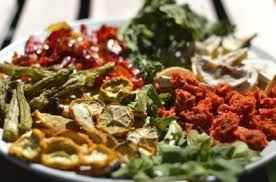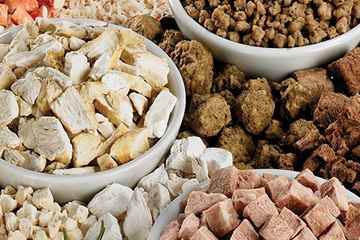Freeze Drying vs Dehydrating Food
Some people save money on produce by gardening themselves. Others buy foods in bulk. In either case, the family savings become even better when processing the bounty by freeze-drying or dehydrating the food. Preserving food properly prevents food from going to waste (along with your money invested in it) by inhibiting microbial growth and expanding shelf life. Freeze drying or dehydrating foods also locks in nutrients. While processing foods via a food dehydrator is a quicker process, freeze-drying enables longer storage times. So which one should you pick? Keep reading and you’ll find the answer.
Food Dehydration Explained
Dehydration is considered to be one of the easiest and oldest means for preserving food. Drying food dramatically reduces the moisture content, controlling growth of bacteria, molds, and yeast for longevity. Produce has a water content ranging from 80 to 95 percent. Various types of meat may contain anywhere from 50 to 75 percent water. If not removed, food spoilage is inevitable.
- Dehydrators commonly used in the home contain a heating element, a fan, air vents, and trays. The heating element, fan, and vents function simultaneously to remove moisture from the food and from within the dehydrator. As the increased temperature warms the food, the fan circulates the warmth around the food, and moisture releases into the air. The fan also blows the moist air out of the dehydrator via the air vents. The dehydration process must continue until the food has less than 20 percent moisture. At this point, the food may bend but typically does not break.
- The trays that come with dehydrators either stack one on top of another or fit tightly onto levered shelves. Each tray has perforations that are small enough to amply hold the food in place, yet allow the warm air to circulate around each slice and each tray.
- The temperature inside the dehydrator sufficiently dries the food when set between 95° F and 145° F. The correct temperature setting varies depending on the type of food being dried. Drying meat requires higher temperatures than what is needed to dry produce. However, if the temperature is set too high, foods dehydrate unevenly on the edges or on the exterior surface of the slice, which leaves too much moisture on the inside.
- Before putting foods into a dehydrator, they must be correctly prepared. Dehydrating fruits and vegetables requires using ripe produce void of blemishes or bruises. The produce is generally cut into slices of 1/8 or ¼ of an inch in thickness. All of the slices put on the trays must be uniform in thickness. Prior to slicing, berries, grapes, and herbs need to be washed. Light-colored fruits and vegetables should be steamed for a few minutes or lightly coated with ascorbic acid or lemon juice to prevent browning. Steaming is also recommended to deactivate the enzyme action that could cause produce to become tough.
- After exposing foods to the appropriate temperature for the recommended length of time, they must be allowed to thoroughly cool. The slices should feel leathery and not brittle or hard. When dehydrated properly, the food at this point contains only about 10 to 20 percent moisture. Fruits need to undergo further conditioning to prevent mold. The slices are put into a glass or plastic jar, closed, and allowed to stand for up to 10 days. Shaking the containers daily keeps the slices separate. If condensation develops inside the container, the food still has too much moisture and must once again go through dehydration.
- Once thoroughly dry and conditioned, dehydrated foods must be packaged in zip-type plastic bags or sanitized glass jars—something airtight. Whatever transparent containment method is chosen, they should be tightly closed. The containers can then be stored in a cool, dark, and dry location. Once dehydrated, fruits last up to one year if the temperature does not exceed 60° F. Vegetables last up to 6 months. However, every time a container is opened, moist air enters. For this reason, dehydrated foods should be checked weekly for signs of spoilage.
About Freeze Drying
Preserving foods by freeze-drying began during World War II. Serums were sent to treat wounded soldiers. But, because the environment had no means of refrigerating the medications, spoilage occurred. Freeze drying was introduced as a means of preservation. The process basically entails exposing foods to extremely low temperatures so that they freeze quickly before visible ice crystals form. During the freezing process, moisture escapes and converts from ice into vapor. With the moisture removed, the food is stored in air and moisture-proof containers.
Freeze drying maintains the cell structure, nutrient content, color, and texture of the food due to the extreme process. The process successfully removes up to 98 percent of the moisture content, which also significantly reduces overall weight. Freeze drying is often preferred when desiring to preserve foods for extended lengths of time. The foods can be stored for years without fear of spoilage.
- The freeze drying process is relatively simple and requires a knife, a metal tray or cookie sheet, a freezer, and either zipped plastic bags or a vacuum sealing device.
- Preparing the foods requires cutting them into small pieces to ensure that the moisture escapes quickly. The food is then placed in a single layer on the tray. The pieces cannot touch each other. Multiple trays can be used if needed.
- The trays are then put into the freezer set at the lowest temperature setting possible. In a typical freezer or refrigerator/freezer, the process takes up to one week. During that time, the door should be opened as infrequently as possible to prevent the temperature from rising or moist air from entering.
- Once the drying process is complete, the food pieces are placed into a zipped plastic bag. The bags must be squeezed to remove as much of the air as possible. Any negligent amount of air remaining can be removed by simply sucking it out through a small open area at the top of the bag. Otherwise, a vacuum sealing device comes in handy. The food remains fresh as long as the bags are not open, until you are ready to use the entire contents.


